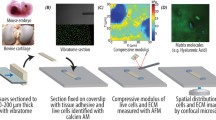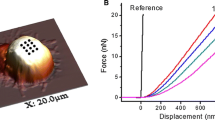Summary
Transmission electron microscopy was used to study the effects of proteolytic enzymes (collagenase, trypsin, clostripain), the calcium chelator ethyleneglycol-bis-(β-aminoethyl ether) N,N,N',N'-tetraacetic acid (EGTA), and the calcium ionophore A 23187 on substrate adhesion and fine structure of chondrocytes and fibroblasts. Monolayer cultured cells responded to treatment with the proteolytic enzymes followed by EGTA or A 23187 by rounding and detaching from the substrate. This was accompanied by the formation of a microvillous surface, deep nuclear folds, and numerous cytoplasmic vacuoles. Labeling experiments with colloidal thorium dioxide indicated that the vacuoles were formed by endocytosis and fusion of endocytic vesicles with preexisting lysosomes. To a variable extent, similar changes were produced by trypsin or EGTA alone. The cells regained their normal fine structure after withdrawal of the reagents and when seeded onto a substrate. In suspension culture, recovery was incomplete; the cells retained a rounded shape and an increased number of cytoplasmic vacuoles.
The results suggest that changes in plasma membrane composition and its permeability to calcium represent the primary signal for cell rounding and detachment. The cellular mechanisms responsible for the associated folding of the nuclear envelope and the cell surface remain unidentified. Nevertheless, this is believed to represent a means of handling of excess membrane during sudden transition from a flattened to a rounded shape. Membrane stored in folds and vacuoles is reutilized when the cells reattach and spread out on a substrate.
Similar content being viewed by others
References
Borle AB (1981) Control, modulation, and regulation of cell calcium. Rev Physiol Biochem Pharmacol 90:13–153
Cliffe SGR, Grant DAW (1981) Calcium-binding constants of trypsin and trypsinogen. A reassessment. Biochem J 193:655–658
Collard JG, Temmink JHM (1976) Surface morphology and agglutinability with concanavalin A in normal and transformed murine fibroblasts. J Cell Biol 68:101–112
Dalen H, Todd PW (1971) Surface morphology of trypsinized human cells in vitro. Exp Cell Res 66:353–361
Dornfeld EJ, Owczarzak A (1958) Surface responses in cultured fibroblasts elicited by ethylenediaminetetraacetic acid. J Biophys Biochem Cytol 4:243–250
Erickson CA, Trinkaus JP (1976) Microvilli and blebs as sources of reserve surface membrane during cell spreading. Exp Cell Res 99:375–384
Follett EAC, Goldman RD (1970) The occurrence of microvilli during spreading and growth of BHK21/C13 fibroblasts. Exp Cell Res 59:124–136
Furcht LT, Wendelschafer-Crabb G (1978) Trypsin-induced coordinate alterations in cell shape, cytoskeleton, and intrinsic membrane structure of contact-inhibited cells. Exp Cell Res 114:1–14
Hefley T, Cushing J, Brand JS (1981) Enzymatic isolation of cells from bone: cytotoxic enzymes of bacterial collagenase. Am J Physiol 9:C234-C238
Johnson PA, Johnstone RM (1981) Alterations in membrane permeability with trypsin treatment. Can J Biochem 59:668–675
Mandl I (1961) Collagenases and elastases. Adv Enzymol 23:163–264
Moskalewski S (1976) Elastic fiber formation in monolayer and organ cultures of chondrocytes isolated from auricular cartilage. Am J Anat 146:443–448
Moskalewski S, Thyberg J (1981) Reversible changes in nuclear and cell surface topography in cells exposed to collagenase and EDTA. Cell Tissue Res 220:51–60
Pressman BC (1976) Biological applications of ionophores. Ann Rev Biochem 45:501–530
Revel JP, Hoch P, Ho D (1974) Adhesion of culture cells to their substratum. Exp Cell Res 84:207–218
Steinman RM, Mellman IS, Muller WA, Cohn ZA (1983) Endocytosis and the recycling of plasma membrane. J Cell Biol 96:1–27
Ukena TE, Karnovsky MJ (1977) The role of microvilli in the agglutination of cells by concanavalin A. Exp Cell Res 106:309–325
Varecka L, Kovac L, Pogady J (1978) Trypsin and calcium ions elicit changes of the membrane potential in pig blood platelets. Biochem Biophys Res Commun 85:1233–1238
Vogel KG (1978) Effects of hyaluronidase, trypsin, and EDTA on surface composition and topography during detachment of cells in culture. Exp Cell Res 113:345–357
Author information
Authors and Affiliations
Additional information
Expert technical assistance was provided by Karin Blomgren and Anne-Marie Motakefi. Financial support was obtained from the Swedish Medical Research Council (06537), the King Gustaf V 80th Birthday Fund and from the Funds of Leiden University
Rights and permissions
About this article
Cite this article
Thyberg, J., Moskalewski, S. Influence of proteolytic enzymes and calcium-binding agents on nuclear and cell surface topography. Cell Tissue Res. 237, 587–593 (1984). https://doi.org/10.1007/BF00228443
Accepted:
Issue Date:
DOI: https://doi.org/10.1007/BF00228443




